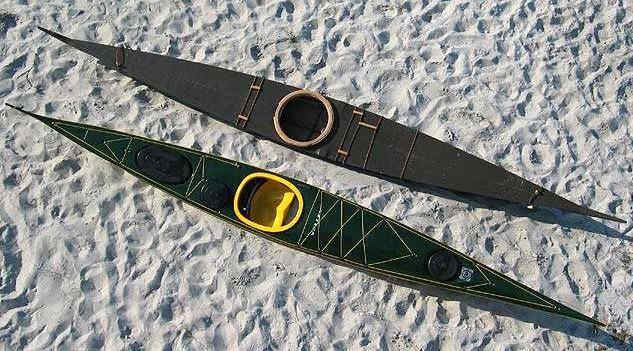- Details
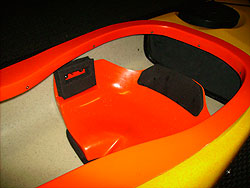
Yesterday I joined the club KVU playing in surf at the coast near Bakkum.
As I am reviewing the Romany-S, I took this kayak for today.
Circumstances at sea were a bit rough as the tide was lowering in combination with a NW-wind that was blowing at 4-5Bft for some time already .
The results were steep dumping waves. At first I had been accompanying a member who wanted to stay closer to shore. But when I was going to accompany the other members, who were at the outer banks, I could not reach them anymore as the dumping waves were grown so strong that they let me flipping backwards on every attempt.
If this flipping backwards is a characteristic of the Romany-S or that it’s just the waves during this session, I don’t know yet. So I will have to go for another surfing session to investigate this. ![]()
- Details
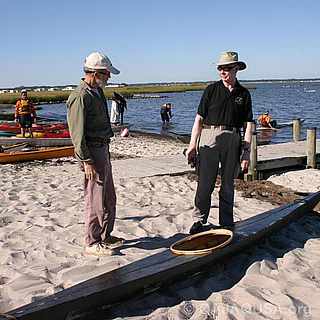
Wow, that´s something!
I just found, at www.qajaqusa.org, pictures of Ken Taylor and Duncan Winning: The two man where the roots of the AnasAcuta started.
As I look at it, it´s those two man who, together with Derek Hutchinson, initiated the development of modern seakayaks until now; well done my boys! ![]()
Looking at the pictures, these man, being in there 60-70ths, are still looking very fit.
- Details
Bonnie made me remember some pictures where the AnasAcuta is compared with a replica of Ken Taylor's kayak.
So it seems a good idea publishing them underneath:
- Details
Introduction
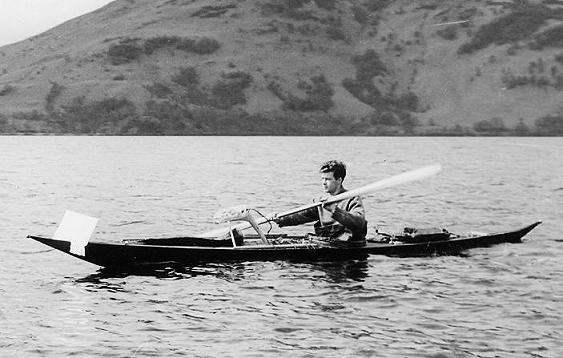 As I paddle an AnasAcuta (VCP - Valley Canoe Products) for years already, I think it´s just about time to write a review on her. :wink:
As I paddle an AnasAcuta (VCP - Valley Canoe Products) for years already, I think it´s just about time to write a review on her. :wink:
The interesting fact about the AnasAcuta, being introduced in 1972 already, is that she is still in production. Which is remarkable because that gives her a history of 36 years!
A kayak with such along history is interesting because we can learn from a kayak that appeals so long to paddlers.
The reason could be that there are enough paddlers who appreciate the beautiful and original Inuit-look of this kayak. But certainly it has also something to do with the capacities of the kayak. Often heard are positive comments on her playfulness and rough water handling: it is just fun, paddling an Anas Acuta. That’s what they say. And I can only agree with that.
KLIK hier om verder te lezen en een grotere foto te bekijken
- Details
Having not paddled the Romany S rm before, the evening of 8 Oct. was an ideal occasion to collect my first paddling experiences with this kayak and to get used to her.
Conditions were very mild on the Alkmaarder-lake (NL: Alkmaardermeer): 8okt 2008, 20.00 h, wind 1-2Bft, no waves above 10cm.
Stability
When fumbling around in the dark to close the zipper of my jacket, while leaving the club, I completely forgot I was sitting in a kayak. Maybe that tells something about the stability.
Edging the kayak felt very natural and did not give you any unstable feelings. In fact the capsizing point is very far away.
- Details
As I wrote in my first post about the Umnak Icefloe Fjord, Derek designed her on request of the Norwegians. He used the Icefloe-design which he modified by taking away the integral skeg. As Willem Molengraaf understood from Derek the hull and deck of the Fjord are equal to the Icefloe.
I quoted in this first post that Derek once talled Willem that he did not like the Fjord.
Just now I found a discussion on the Sea&Surf-forum where Owen wrote something similar on the 26th april 2007:
- Details
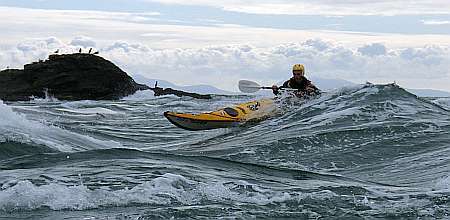 Paddling the Fjord in the tideraces around Anglesey seemed an ideal opportunity to learn more about here capacities. We went in sept´08 with a group of 7 kayakers (mostly from Kayakclub Uitgeest) to Holy Head in Wales.
Paddling the Fjord in the tideraces around Anglesey seemed an ideal opportunity to learn more about here capacities. We went in sept´08 with a group of 7 kayakers (mostly from Kayakclub Uitgeest) to Holy Head in Wales.
Axel Schoevers was our guide (Click for his weblog) and we had a perfect paddling-week. Axel guided us to Puffin Island, North Stack, South Stack, Skerries and Penrhyn Mawr.
To be honest, being at sea the combination of strong currents and waves was a bit intimidating at first. But as Axel slowly increased the level, the learning-curve was perfect.
- Details
Op de KVU waren een paar leden met Axel naar Anglesey geweest om daar de varen in de stroomversnellingen in de sterke getijdestromen.

Aangestoken door hun enthousiasme ontstond in 2008 het idee om dat nog een keer te herhalen met een groepje KVU-ers. Axel Schoevers, die heel bekend is met de omstandigheden bij Anglesey, werd benaderd en hij was bereid dat voor ons te organiseren als gids. Wel vroeg hij of hij ook niet-KVU-ers ook kon meenemen. Dat zou de kosten wat drukken. En zo is het gelukt en reisden we in augustus 2008 voor 1 week avontuur met ferry en per auto naar Anglesey.
We kampeerden op een camping in de buurt van Holyhead en gingen dagelijks, afhankelijk van de weersomstandigheden, met begeleiding door Axel de zee op.
Hieronder een filmpje van 15 minuten met een beeld hoe mooi het daar is en hoe de zee er uitziet:
Los daarvan hadden we nog een excursie naar kanobouwer NDK waar we een rondleiding kregen door Nigel Dennis "himself".
Toevallig zag ik daar een kano-wrak in een hoekje liggen : een NDK Greenlander. Die had in de branding een aanvaring gehad waarbij de achterpunt er nu los bij hing.
Ik had daar wel interesse in en kocht hem als test-case om de kajak onzichtbaar de repareren.
Het verslag daarvan vind je op: the Greenlander from NDK
Behalve ons filmpje hierboven kregen we ook een film van NDK mee. Klik hier om dat NDK-filmpje te downloaden
- Details
In addition to the first dry impression that I wrote before, I now looked for the design-briefing which NDK followed in designing this Romany, as well as for some more technical information.

- Details
As the kayakclub bought herself a new Romany S rm, I got the opportunity to take a close look to this new kayak which is introduced by P&H (OEPS: I mean NDK of course) in march 2008.

Later I will take her along for a paddle, but first I will take a technical look underneath:

